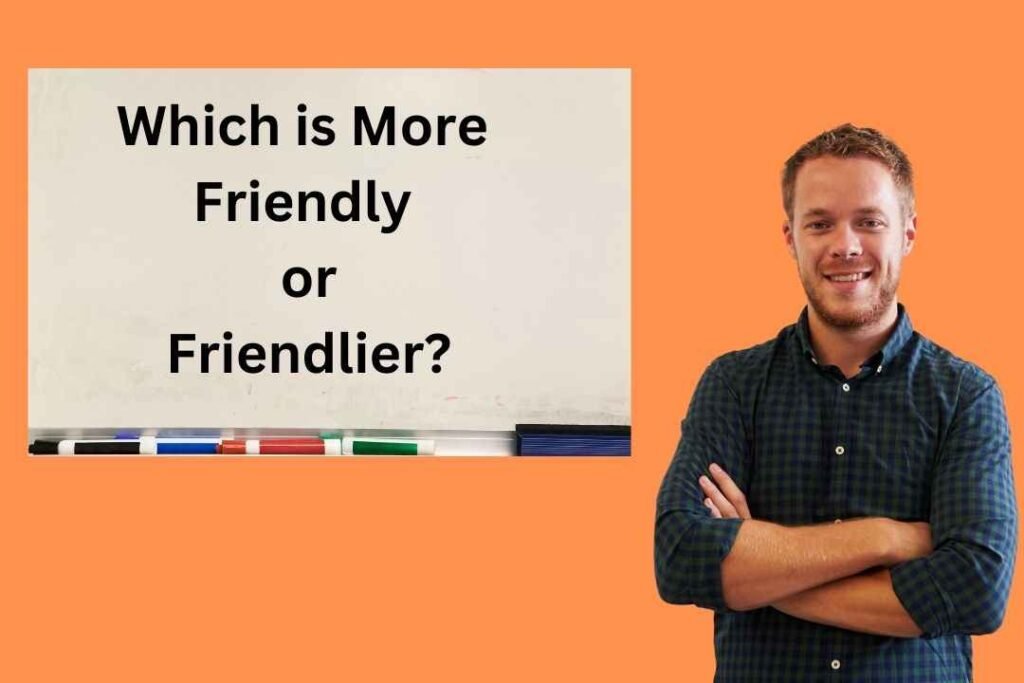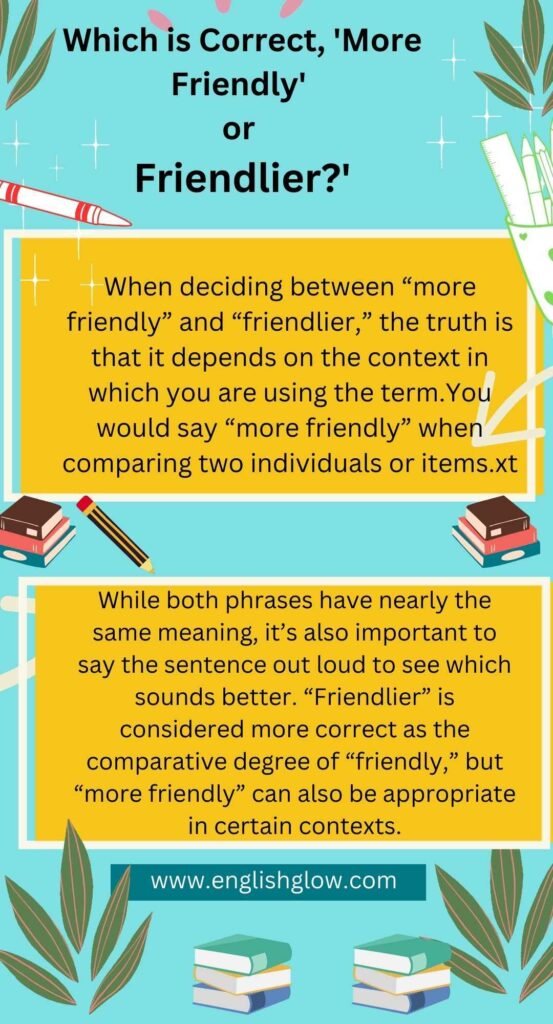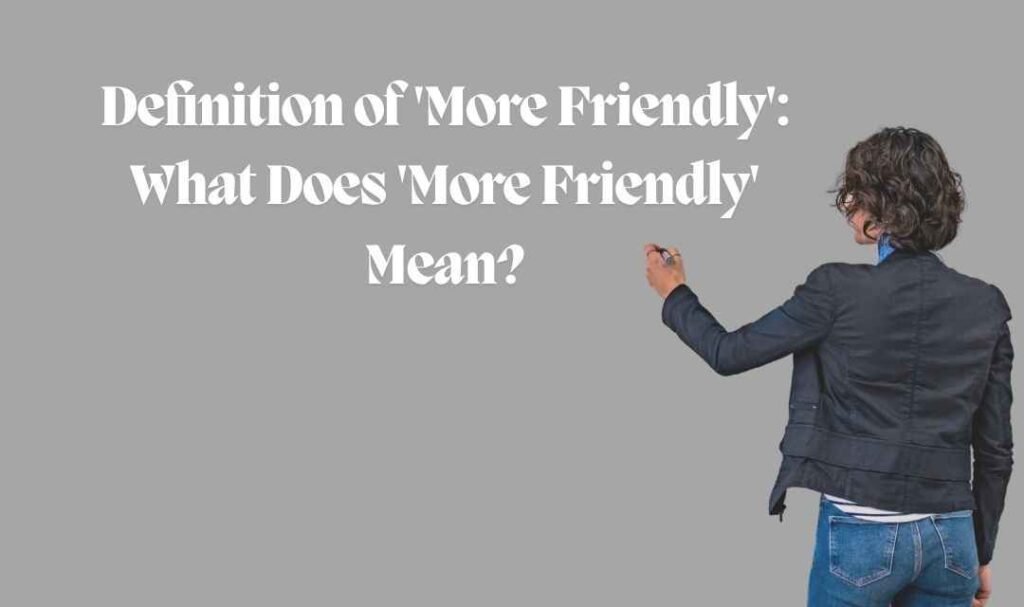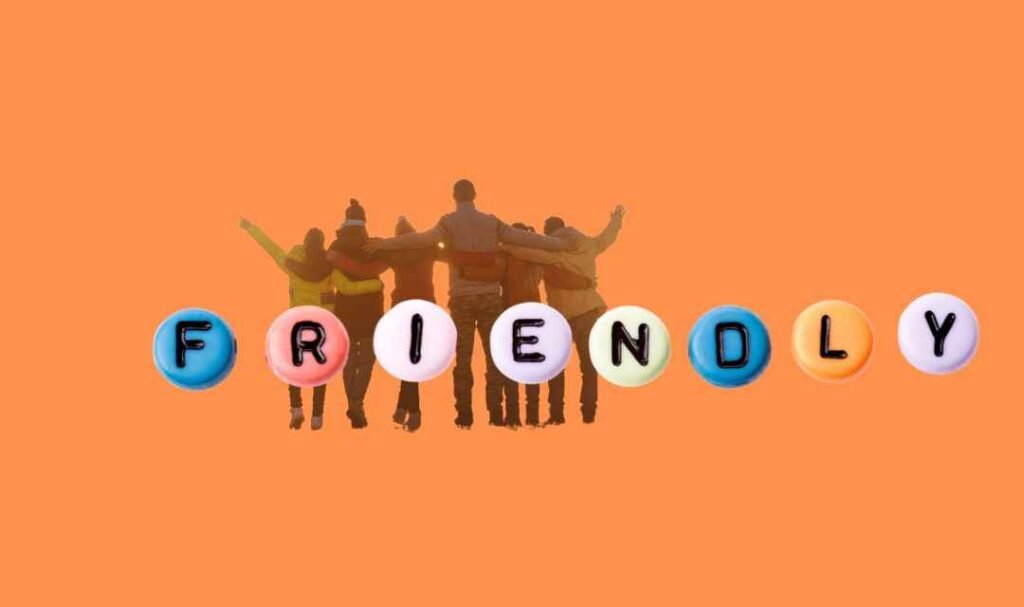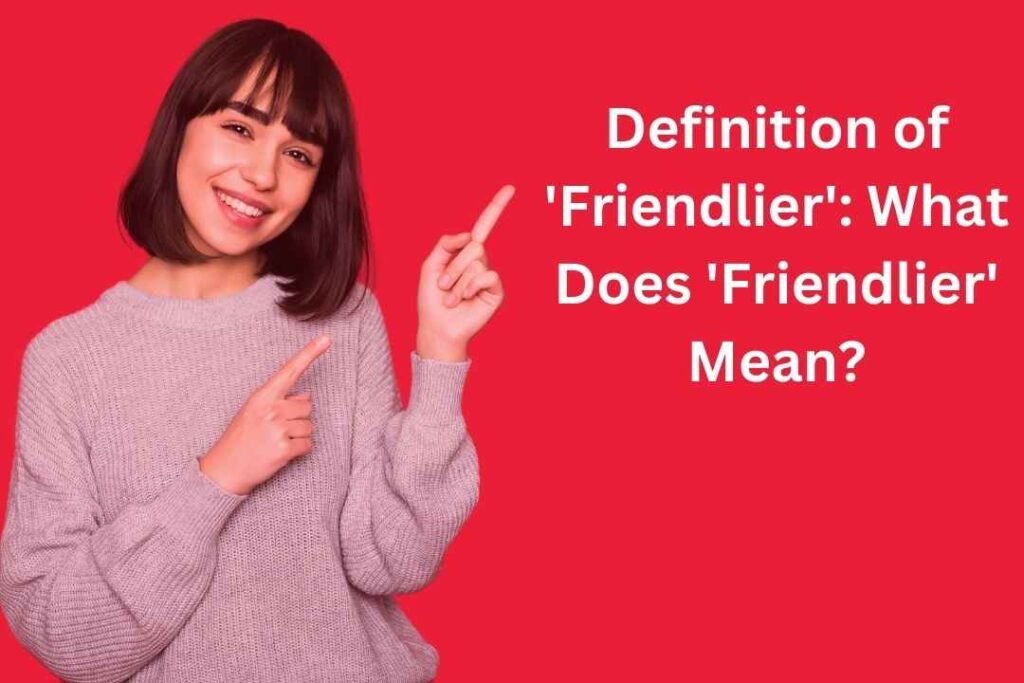Which is more correct: friendly or friendlier? It’s a question that might have crossed your mind, whether you’re aiming to sound natural in conversation or writing a polished essay. Surprisingly, there’s more to this question than meets the eye! In English, adjectives can take on different forms depending on context and emphasis, and understanding when to use more friendly or friendlier can make a big difference in how you communicate. Dive in as we explore the nuances of these words and uncover the surprising answer to which one truly fits best in your sentence!”
When you say, “My dog is friendlier than your cat,” you are directly comparing the friendliness of the two animals. On the other hand, if you say, “She is more friendly than her brother,” you are using the phrase to show a difference in behavior. Both forms are acceptable, but it’s good to know which one to use in different situations.
Some might feel that “friendlier” is more natural because it fits the typical structure of English adjectives. However, “more friendly” is also correct, especially in formal contexts. It’s essential to keep your audience in mind and choose the form that feels right for the situation. Understanding how to use these phrases correctly will help you communicate more effectively.
Which is Correct, ‘More Friendly’ or ‘Friendlier?’
When deciding between “more friendly” and “friendlier,” the truth is that it depends on the context in which you are using the term.You would say “more friendly” when comparing two individuals or items.. For example, you might say, “In our neighborhood, there are more friendly people than in the city.” On the other hand, you would use “friendlier” when making a statement directly to or about someone. For example, “My new neighbor is more friendly than my old one.”
While both phrases have nearly the same meaning, it’s also important to say the sentence out loud to see which sounds better. “Friendlier” is considered more correct as the comparative degree of “friendly,” but “more friendly” can also be appropriate in certain contexts. For example, if you want to say that you encountered more people who are friendly, you could say, “We’ve come across more friendly people there.”
In everyday conversation, saying “friendlier” might feel more natural, but “more friendly” is perfectly acceptable too. So, the next time you’re comparing friendliness, just remember the context and choose the phrase that fits best!
Example
- Correct: “She is friendlier than her sister.”
- Correct: “This town has more friendly people.
You might enjoy reading: Esetted or Reset? Discover the Best Option for You!
Definition of ‘More Friendly’: What Does ‘More Friendly’ Mean?
To learn more about the term “more friendly,” we first need to understand the word “more.” According to the Merriam-Webster Dictionary, “more” is an adjective that means greater, further, or additional. It can also be used as an adverb, meaning moreover or in addition. When we say “more friendly,” we are comparing the friendliness of two or more people or things, indicating that one is friendlier than the other.
In the context of using “more friendly,” it’s important to remember that this phrase emphasizes the degree of friendliness. For instance, if you say, “She is more friendly than her sister,” you are clearly stating that one person shows greater friendliness compared to another. This phrase is quite common when discussing relationships or interactions between people.
Using “more friendly” is correct, especially in informal conversations. However, it’s good to note that many people might prefer “friendlier” as it is a more direct comparative adjective. Ultimately, both forms are understood, and you can choose which one fits best in your sentence!
Example
- In our neighborhood, my friend is more friendly than anyone else.
- Compared to last year, our dog is now friendlier to strangers.
Definition of ‘Friendly’
The word “friendly” is an adjective that describes qualities related to a friend. It means being not hostile and showing goodwill or a kind interest in others. A friendly person is someone who is cheerful and comforting, often serving a helpful purpose. For instance, in a community, a friendly neighbor might greet you with a smile and offer help when needed.
The term can also refer to things that are designed to be easy to understand or use, making them user-friendly. In this context, being friendly implies that something is made to not cause harm or confusion. As an example, a friendly website is one that is simple to navigate, ensuring users can find what they need without frustration.
Additionally, “friendly” can function as an adverb, meaning to act in an amicable manner. It can also be a noun, referring to a friendly person or a match-up between two teams that does not impact their rankings or scores. Overall, being friendly creates a positive atmosphere that encourages cooperation and kindness.
Example:
The staff at the local library are always very friendly, making visitors feel welcome.
Definition of ‘Friendlier’: What Does ‘Friendlier’ Mean?
Understanding the difference between “more friendly” and “friendlier” is important for clear communication. Friendlier is a comparative adjective that means being friendly or having good relations with someone. It describes a person or thing that is more sociable than another. For example, you might say, “My new neighbor is friendlier than the old one,” indicating that the new neighbor is easier to get along with.
The term friendlier also suggests a beneficial relationship. For instance, if you say, “This policy is friendlier towards the environment,” it means the policy has a positive impact. In contrast, more friendly can also be correct but is often less commonly used. While both forms convey a similar meaning, using friendlier is usually preferred in everyday language. It’s good to keep in mind that language evolves, and what sounds better can change over time.
Example
When talking about social interactions, saying “She is friendlier than her sister” implies that she engages more positively with others. On the other hand, if you say, “She is more friendly than her sister,” it is also correct, but it may sound a bit awkward to some listeners.
Pronunciation Guide: How to Say ‘More Friendly’ and ‘Friendlier
Pronunciation is important when you are learning terms like ‘more friendly’ and ‘friendlier.’ Knowing how to pronounce these words helps you understand their spelling and how to use them correctly. If you are giving speeches or writing content for a client, mastering the pronunciation ensures that your communication is clear.
To pronounce ‘more friendly,’ you can use this phonetic spelling: mor fren(d)lee. This makes it easier to remember and say correctly. For the term ‘friendlier,’ the phonetic spelling is fren(d)lee-ur. Using the right pronunciation helps you avoid confusion and ensures that others understand you clearly.
Learning these pronunciations is a small step that can make a big difference in how you communicate. Whether you are speaking in front of an audience or discussing with a friend, saying these terms correctly can boost your confidence and effectiveness.
Example: When describing someone who is pleasant, you might say, “My neighbor is more friendly than the others,” or “She is friendlier than her sister.”
you might enjoy reading: How-Tos or How-To’s? Discover the Correct Plural Form Now!
Sample Sentences Using ‘More Friendly’ or ‘Friendlier’
When trying to choose between more friendly and friendlier, it can be tricky to figure out which one works best. Both expressions are grammatically correct, but they are used in slightly different situations depending on how the sentence is structured. When comparing, the word friendlier is often used when speaking more casually, while more friendly tends to appear in more formal writing or speech. This subtle distinction can shape how you convey your message to others.
For instance, imagine you’ve written a low-content book titled Dogs Are More Friendly Than Cats, where you argue that dogs make better companions because they tend to be more friendly toward humans. Whether discussing friends, family, or co-workers, the phrase more friendly could be helpful in formal settings. For instance, someone might ask, “What can I do to be more friendly to my colleagues?”
Or comment, “Some countries are more friendly than others when it comes to tourism.”
On the other hand, if you’re chatting with a friend, you might say something like, “Angela is much friendlier every time we hang out,” or share a memory from the past, such as, “I recently visited my writing teacher from high school, and she was much friendlier than I remembered.” These casual exchanges often lean on the more relaxed tone of friendlier, creating a sense of warmth. When reflecting on how nicer people treat you when you’re friendlier, the choice of words flows naturally in daily conversations. Even when catching up with someone like Jane and noticing how her behavior has shifted, you might say, “I saw Jane this morning, and she was a lot friendlier than before
Final Analysis: ‘More Friendly’ Versus ‘Friendlier’
When it comes to choosing between more friendly and friendlier, it’s important to understand how both terms work. After going through a ton of information in this post, you’ve probably realized that the difference lies in how we use these words in comparisons. More friendly is a comparative clause used to associate two or more people or things, often in formal situations. For example, you might say, “This team is more friendly than the other one,” emphasizing a comparison between groups. On the other hand, friendlier is a comparative adjective that works in a similar way, but it’s often preferred in casual conversations or writing. For instance, “She seemed much friendlier after the meeting” feels more relaxed.
In summary, both words are correct, and you can use them interchangeably based on the tone you want to set. The quick recap here is that you’ve learned the difference: use more friendly for formal comparisons and friendlier for more casual ones. Both expressions allow you to express comparisons effectively, depending on how formal or relaxed the context is
FAQ
Do we say “more friendly” or “friendlier”?
Both “more friendly” and “friendlier” are correct, but “friendlier” is more commonly used. “Friendlier” follows the standard comparative form for short adjectives, while “more friendly” can be used for emphasis or in formal contexts.
What is the difference between “friendly” and “friendlier”?
“Friendly” is the base form of the adjective, meaning kind, pleasant, or sociable.
“Friendlier” is the comparative form, meaning more friendly than something or someone else. It compares two or more entities in terms of friendliness.
How do you use “friendlier” in a sentence?
Example sentence:
“Since the new manager started, the office environment has become much friendlier.”
This sentence compares the office environment before and after the new manager started, showing it has become more friendly.
Is it “most friendly” or “friendliest”?
“Friendliest” is the correct superlative form, meaning the most friendly of all. You can also say “most friendly”, but “friendliest” is more common and concise.
Example:
- Correct: “She is the friendliest person in the group.”
- Also correct but less common: “She is the most friendly person in the group.”
Can I use both “more friendly” and “friendlier” in formal writing?
Yes, both are acceptable, but “friendlier“ tends to be used more frequently in both formal and informal writing. “More friendly” can be used for emphasis or to avoid confusion in certain contexts.
What is the correct plural form: “most friendly” or “friendliest”?
“Friendliest” is the superlative form, indicating the highest degree of friendliness, whereas “most friendly” can be used but sounds less fluid.
Example:
“Our dog is the friendliest among all the pets.”
Comparative and Superlative Degrees of “Friendly”
Q1: What is the comparative degree of “friendly”?
A: The comparative degree of “friendly” is “friendlier.” It is used to compare the friendliness of two people or things. For example, you might say, “My new neighbor is friendlier than the previous one
What is the superlative degree of “friendly”?
A: The superlative degree of “friendly” is “friendliest.” This form is used when comparing three or more subjects. For example: “Among all the contestants, Sarah is the friendliest.”
How do I use “friendlier” in a sentence?
A: You can use “friendlier” to indicate a comparison between two subjects, such as: “This restaurant is friendlier than the one we visited last week.”
Can you provide an example sentence using “friendliest”?
A: Certainly! An example would be: “John is known as the friendliest person in our office.”
Are there alternative forms to express the comparative and superlative degrees of “friendly”?
A: Yes! Instead of “friendlier,” you can say “more friendly,” and instead of “friendliest,” you can say “most friendly.” For example, “She is more friendly than her colleagues,” and “He is the most friendly person in our group.”
Q6: Is there a difference between using “friendlier” and “more friendly”?
A: There is no significant difference in meaning. “Friendlier” is the more commonly used form, while “more friendly” is also correct and can be used for emphasis.

